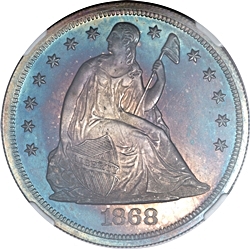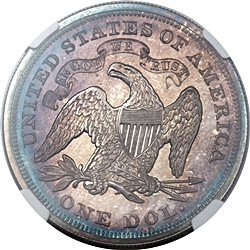 |
1868
 

|
 |
General Comments
1868 saw a huge increase in Seated dollar mintage. However, most were apparently exported to the orient.
As a result, the date is much scarcer than its high mintage would indicate. It should be considered as
underrated in all grades, although the market has done a reasonable job of recognizing the rarity of mint
state examples. They consistently bring prices that are much stronger than the surrounding dates. Lower
grade examples, however, seem to sell near common date prices, although a close look at auction records
will show that premium quality examples, particularly pleasing coins in the XF-AU grade ranges, often bring
extremely strong prices.
|
| |||||||||||||||||||||
In proof, the finest known example is a single PR68 cameo graded by NGC. PCGS has graded two coins at the PR67 level, one of these designated deep cameo. NGC has given 5 coins a PR67 grade, including two designated cameo, and one ultra cameo. Fifteen additional coins have received a grade of PR66, six by PCGS and nine by NGC, while 56 have been evaluated as PR65. 547 coins have been encapsulated as proofs at all grading levels. Population statistics are as of November, 2023. These statistics surely include a significant number of re-submissions. I estimate the total proof population to be around 450 coins.
1868 examples are usually well struck. Star centrals are normally sharply defined, only occasionally showing very slight weakness. All other details are normally above average. Reverses are usually sharp, only occasionally displaying slight weakness on the upper left wing. Proofs often show slight weakness on the upper left wing, and occasionally on the feathers of the left leg. High-grade business strikes are often prooflike or semi-prooflike, but frosty examples can be located.
1868 Die Marriages
7 die marriages have been positively identified. Three obverse dies were combined with three reverses to strike five business strike die pairs. All reverse dies were unique to 1868. None of these dies were used for proofs. Two proof die pairs used two different obverse dies, each paired with 1866 Reverse PA, now in its third year of use. The following table summarizes the known die marriages for 1868:
Click the links below to view the details of each die marriage.
Die Marriage |
Rarity |
Obverse Die |
Reverse Die |
Estimated Survivors |
| OC-1 | R3- | 1 | A | 470 |
| OC-2 | R4 | 2 | A | 160 |
| OC-3 | R4- | 2 | B | 190 |
| OC-4 | R3+ | 3 | B | 270 |
| OC-5 | R3- | 3 | C | 410 |
| OC-P1 | R4 | P1 | 1866 PA | 150 |
| OC-P2 | R3+ | P2 | 1866 PA | 300 |
1868 Business Strike Emission Sequence
With every die marriage including die overlap with either a previous or a subsequent die marriage
the emission sequence was relatively easy to determine.
Emission Order |
Die Marriage |
Comments |
| 1 | OC-1 | |
| 2 | OC-2 | Die cracks in late reverse states place OC-2 after OC-1 |
| 3 | OC-3 | Reduction in the unfinished area under the chin indicates OC-3 after OC-2 |
| 4 | OC-4 | Die cracks on Reverse B in its OC-4 use place OC-4 after OC-3 |
| 5 | OC-5 | Slight reduction in unfinished areas indicates OC-5 after OC-4 |
1868 Proof Emission Sequence
Both proof die marriages share the same reverse, but there was very little degradation in that
reverse die. This is simply my best guess based on microscopic evaluation of the condition of Reverse 1866 PA
in each die marriage.
Emission Order |
Die Marriage |
Comments |
| 1 | OC-P1 | |
| 2 | OC-P2 | I believe that this represents the latest state of Reverse 1866 PA, but the degradation is barely detectable, so significant uncertainty still exists. |
1868 Quick Finder Chart
Attribution of 1868 die marriages is relatively easy. Date positions are similar, but most obverses display other
characteristics that distinguish them. The following table lists the keys for identifying each die marriage:
Die Marriage |
Obv Die |
Rev Die |
Right |
Keys |
| OC-1 | 1 | A | B | Obverse: 6 in denticles. Lump in drapery. Reverse: Die line in motto from bottom of E through TR. |
| OC-2 | 2 | A | JR of LE | Obverse: 6 in denticles, business strike MPD-001. Reverse: Die line in motto from bottom of E through TR. |
| OC-3 | 2 | B | JR of LE | Obverse: 6 in denticles, business strike MPD-001. Reverse: A small lump left of the W in the motto. |
| OC-4 | 3 | B | JR of LE | Obverse: Numerous die lines in the denticles below the 6. Reverse: A small lump left of the W in the motto. |
| OC-5 | 3 | C | JR of LE | Obverse: Numerous die lines in the denticles below the 6. Reverse: Die line through upper part of M. |
| OC-P1 | P1 | 1866 PA | L QTR | Obverse: 18 on rim, proof MPD-001. Reverse: A heavy horizontal die line in the motto from the top right corner of the N through the bottom of GOD. |
| OC-P2 | P2 | 1866 PA | RE | Obverse: Tripled 1, repunched 8's. Reverse: A heavy horizontal die line in the motto from the top right corner of the N through the bottom of GOD. |
| Photo credits:
Obverse and reverse full photos: 1868 NGC PR68 Cameo, finest known, from the Heritage archives. |
